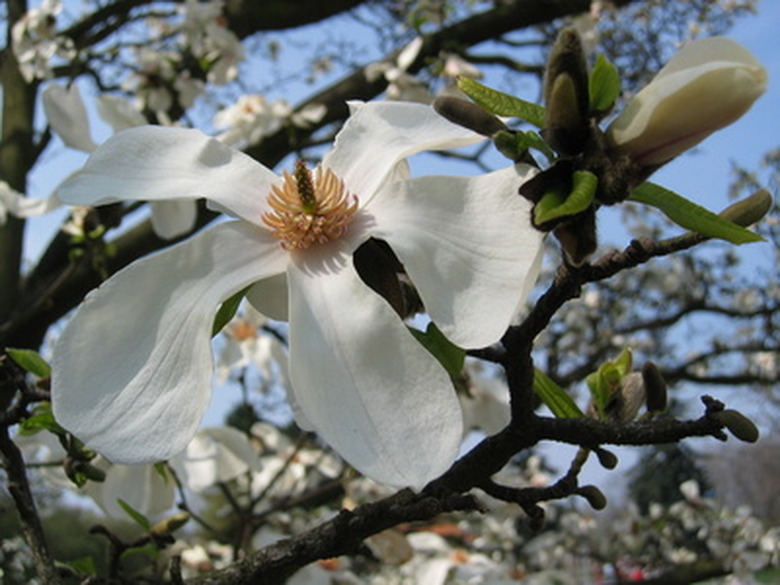Flowering Trees Of Florida
Florida's warm climate is home to hundreds of flowering trees, both native species and nativized imports. Native flowering trees are often overlooked because of the much showier imported species, but conservationists at the University of Florida Extension Service recommend landscaping with native varieties because they are lower maintenance in terms of fertilizer and irrigation, they are more disease- and pest-resistant, and they help conserve the natural beauty of Florida.
North Florida
North Florida's USDA hardiness Zone 8 supports an array of flowering and coniferous trees. One commonly found native tree is the southern magnolia (Magnolia grandiflora), a deciduous evergreen that flowers in the spring. Southern magnolia blooms are white or pinkish-white with a distinctive aroma. The tree can reach 80 feet tall, and the blooms open up to 8 inches across.
Another common native tree in northern Florida is the flowering dogwood (Cornus florida). This spring flowering beauty actually has false white or pink flowers (called bracts) that surround the small, yellow true flowers. The dogwood's leaves turn deep red in the fall.
- Florida's warm climate is home to hundreds of flowering trees, both native species and nativized imports.
- One commonly found native tree is the southern magnolia (Magnolia grandiflora), a deciduous evergreen that flowers in the spring.
The loblolly bay (Gordonia lasianthus) is also common in north Florida, popular because it blooms in the spring and often continues flowering through the summer. Its small, white flowers are cup-shaped and fragrant.
Central Florida
Central Florida's climate can support all but the most heat-loving tropical trees in Florida. This part of the state falls in USDA hardiness Zones 9 and 10, and is home to a large variety of native species. The swamp hibiscus (Hibiscus coccineus) is commonly found in central Florida because it grows well in swampy, poorly drained soils. Although it is actually a shrub, it can reach 10 feet tall. It has showy red blooms with large delicate petals and yellow centers.
- The loblolly bay (Gordonia lasianthus) is also common in north Florida, popular because it blooms in the spring and often continues flowering through the summer.
- The swamp hibiscus (Hibiscus coccineus) is commonly found in central Florida because it grows well in swampy, poorly drained soils.
The devil's walking stick (Aralia spinosa) gets its name from the spines on its branches and trunk. Although it prefers shade, it grows well in areas that have recently been cleared which make it a good landscaping plant for the region. Its clusters of tiny white flowers are attractive to bees and other beneficial insects.
Another commonly grown native in central Florida is the chickasaw plum (Prunus angustifolia). This decorative tree is popular because it starts to flower earlier than other trees, when it becomes covered with sweet-smelling white blooms. The fruit is edible and often made into jam.
Southern Florida
The tropical climate (USDA Zone 11) of southern Florida hosts a large variety of exotic flowering trees and shrubs. The sweet acacia (Acacia farnesiana) is a rotund deciduous tree commonly found in the region. This tree has fragrant, yellow ball-shaped flowers and delicate feathery leaves. It can reach heights of 30 feet.
- The devil's walking stick (Aralia spinosa) gets its name from the spines on its branches and trunk.
- Its clusters of tiny white flowers are attractive to bees and other beneficial insects.
Another flowering tree that grows in parks and home gardens in southern Florida is a hardwood tree called the princewood (Exostema caribaeum). Listed as an endangered species in the wild, this summer blooming tree has distinctive star-shaped flowers with extremely slender, delicate petals.
The sea grape (Coccoloba uvifera) is another flowering tree that is found all over the southern Florida landscape. This tree can grow up to 30 feet tall, with many branches low on the trunk. The whitish flowers bloom on long, flexible stalks which later turn into fruits resembling bunches of green grapes.
